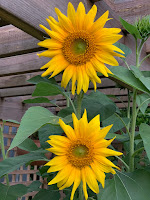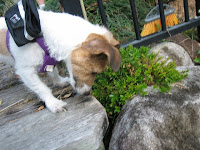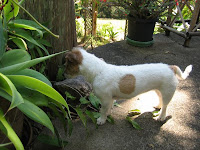My best ally in the battle to keep mice and other rodents a safe distance from my kitchen had to be the majestic carpet python who visited us each winter for years. I like to think that the snake we sighted at least once or twice each winter was one and the same individual, and not a procession of passers-by. But though we have many photos of the python’s arrival and departure over successive years, we don’t have sufficiently similar ‘poses’ to positively identify the markings

(assuming these differ for each individual). However, on two successive years we documented ‘our’ python following the exact same route into its wintertime lair. It arrived both times via overhanging greenery on the southern side of the house and slid onto the roof of the carport on that side, moved (very slowly) around to the western side of the house, where it would slither down into the rafters of the veranda. From there it turned another

corner into the rafters of the north-facing veranda and travelled the full length of that long side of the house, arriving finally at a tiny opening just above one rafter, where it would inch its way into the attic crawl space above the ceiling of A’s office. This happened in June 2006, and again in July 2007.
Now and then during the winter months in those years, as I lay in bed at night I would imagine I could hear the soft swishing noise of snake moving around up in the roof-space. More likely, however, the python lay quite motionless throughout the cold season, possibly keeping just a bit warmer up there than it would have out in the bush. One thing we definitely did not hear as long as the python was up there was the scratching of rodents scampering about in the ceiling space, as we did used to hear in earlier years, before the python became a winter boarder. But sometimes I would worry that if the snake did find a meal of rat up there before trying to come out at the end of winter, it might well get stuck in that tiny hole. One of the roof’s galvanised iron sections would then have to be lifted to free it. After all, we had experienced the awful stench of a dead rat in the attic and I could just imagine how much worse it would be to have so many kilos

of dead python rotting up there. But thankfully, the python never did get stuck. In fact, he probably always ended the winter skinnier than when he arrived. Six or eight weeks after his arrival, he would come out the same way he went in, and retrace his way back to the trees on the opposite side of the house. Of course, it’s possible he went in and out several times before finally abandoning the overheated roof-space for the warmer months. Maybe I just happened to have seen only one of numerous exits and re-entrances. But eventually it would get too warm up there under the roof even for him, and the python would disappear into the surrounding vegetation for the summer.

One year, just as the snake was about to come out of the roof-space, his emerging dark head against the white paintwork was spotted by a resident flock of noisy miner birds feeding nearby. They raised the alarm and with the help of their usual enemies, blue-faced honeyeaters, the birds all took turns dive-bombing at the python’s head. He ducked in and out a few times, obviously fearing for his eyes. Eventually, deciding that this was not a promising day, he retired for another 24 hours. The next day he managed to slip out and away without any birds noticing.
Unfortunately in April 2008 my python (or if not ‘my’ python, then a cousin or close-enough friend to be sharing the same environment) had a nearly fatal accident just outside my studio. And I fear the experience may have given him such a shock that he has abandoned our block as too dangerous a place to hang around. Here’s what happened.
In a shady corner near the entrance to my little studio, I found some frog eggs in a large saucer of water that sits under a big pot plant. I had recently seen a very pretty tree frog near there, so I decided to place a scrunched-up section of bird netting around the saucer, hoping to keep the eggs and then tadpoles safe from cane toads. I thought that maybe some of the froglets might make it to maturity, safe from marauding cane toads and with the added shelter created by the netting. A few days later, as I was coming out of the door from my studio, my eye caught movement over in that corner. I turned to see that the pot plant was lying on its side. Tangled up in the bird netting at its base and thrashing about was a small python. The snake must have been there for some time already because the large mesh of the bird netting was wrapped tightly around the snake’s body in several different places. Only the head and about 30 cm of the python’s body were free of the netting. Everything after that was totally entangled.
As I approached the desperate python lunged at me, but I managed to pick up the snake-and-netting bundle by its tail and drag it clear of the corner, out into the pathway. But this was more than a one-person job, so I rang my neighbour, D.S., an 84-year-old gentleman who goes around the neighbourhood digging up feral weeds in bushland backyards and generally keeping an eye on local fauna and flora. I knew he had ‘transplanted’ a stubborn python who on several occasions had taken up residence in another neighbour’s garage. (Personally, I would been happy to have such a python living in my garage, but this neighbour was a recent

migrant from England and he wasn’t comfortable not knowing where the snake would be each evening as he arrived home from work.) I thought that between us, D.S. and I might be able to free this python from his bonds.
Pythons aren’t poisonous, of course, but they can bite. And that bite can carry infection. Anyway, if we were going to be able to free the snake, we needed to keep it reasonably quiet during the process. D.S. used the handle of his cane to gently immobilise the python’s flailing head, and then grabbed hold of the snake right behind the head. I fetched my sewing shears and, as D.S. held the upper body secure, I located the first piece of netting in which the body was stuck fast. The undulating motion of the snake’s muscles as it continued to try and writhe itself free meant that for just a few seconds, each section of body would contract slightly. And each contraction allowed me just enough slack to slip one blade of the scissors in between the snake’s skin and a strand of bird net.

In this way, snip by snip, we were able to free the python from the tangled netting. When we’d finished and the netting was removed, we placed the python down on the terrace and released it. I noticed then a slight bulge at one point in the body, which was probably whatever rodent or frog had attracted the snake to dive into the netting in the first place. The freed snake gave itself a good shake, had a bit of a rest, and then, slowly, moved off. It entered the front terrace garden, slithered up a lime tree, and from there moved on into nearby taller trees where it disappeared in the vegetation.
That, I fear, may well have been the last we will see of a python near the house for quite a while. I like to think the snake appreciated that D.S. and I were being good Samaritans, but I think more likely it filed us and our garden under the heading: ‘People and places to avoid in the future’. How else can we account for the fact that ever since that day in April 2008, even though A and I have spent more time at home and less time travelling than ever before in the 13 years

we have lived here, we have not seen another python on the block. We have seen the occasional green tree snake and a few not precisely identified ground snakes (unfortunately, several were probably brown snakes, in spite of not being identifiably brown in colour!). But we have not seen another python. And another telltale sign of the python’s absence: we have again seen or heard mice and a rat or two inside my safety zone. I don't suppose our birds will miss the python. The one in this picture sheltered for a few weeks in a dry roof gutter, coming out each morning to lie in wait for any birds that might be visiting our feeders. I found him on his first day, poised motionless right above a hanging feeder, looking so much like a dead branch you can hardly see him in this photo. I shoo'd him off and moved the feeder to another location, or we might have lost a parrot or two.

We’ve had other drop-in visitors, of course – lace monitor lizards, a water dragon that mistook our pool for a dam (I had to lift him out of the pool in my leaf-collecting basket), a wallaby now and then and, most regularly, possum. Almost every night at certain times of the year a big old male possum calls in at our various bird feeders to see if the parrots have left anything

behind. Sometimes a mother with a young one at her heels will scamper down from the roof, which seems to be a major possum highway, judging by the pounding of feet we hear. One night, Mother Possum made too fast a retreat, leaving her juvenile stranded on the bird feeder. The youngster took a quarter of an hour to find a way back up to the roof, where Mum was waiting. It’s a while since we’ve seen an echidna, but now and then they too pass by – the one below trying in vain to look invisible by burrowing into the litter and soil at the stump of a dead gum tree. But I still miss my python (or pythons) and continue to

check out their favourite haunts regularly, hoping maybe that snake we rescued will forget the trauma it endured and remember instead what a snug winter home it once had in our attic. I don’t think we have a boarder up there this winter, but even so, I won’t be entering the crawl space to check. Coming face to face with a python while crawling on hands and knees in the attic is a treat I can happily forego.
Postscript: I'll talk about visiting birds in a separate post.
 Opening the book this morning, after writing last night's piece about my troublesome palm nuts, I couldn't help but ponder how in one of RF's notebooks the little annoyance of nature I blogged about would have morphed into a sonnet or some other poetic form, with one of those quietly, sometimes deadly, aphorisms in the last line or two: e.g. "And they, since they / Were not the one dead, turned to their affairs."(Out, Out – ); or "I took the one less traveled by, / And that has made all the difference"(The Road Not Taken); or "And miles to go before I sleep, / And miles to go before I sleep" (Stopping by Woods on a Snowy Evening). Or maybe something as rueful as the closing lines of Reluctance, where, as Parini writes, "frustrated hopes are mirrored in a dying landscape":
Opening the book this morning, after writing last night's piece about my troublesome palm nuts, I couldn't help but ponder how in one of RF's notebooks the little annoyance of nature I blogged about would have morphed into a sonnet or some other poetic form, with one of those quietly, sometimes deadly, aphorisms in the last line or two: e.g. "And they, since they / Were not the one dead, turned to their affairs."(Out, Out – ); or "I took the one less traveled by, / And that has made all the difference"(The Road Not Taken); or "And miles to go before I sleep, / And miles to go before I sleep" (Stopping by Woods on a Snowy Evening). Or maybe something as rueful as the closing lines of Reluctance, where, as Parini writes, "frustrated hopes are mirrored in a dying landscape": Opening the book this morning, after writing last night's piece about my troublesome palm nuts, I couldn't help but ponder how in one of RF's notebooks the little annoyance of nature I blogged about would have morphed into a sonnet or some other poetic form, with one of those quietly, sometimes deadly, aphorisms in the last line or two: e.g. "And they, since they / Were not the one dead, turned to their affairs."(Out, Out – ); or "I took the one less traveled by, / And that has made all the difference"(The Road Not Taken); or "And miles to go before I sleep, / And miles to go before I sleep" (Stopping by Woods on a Snowy Evening). Or maybe something as rueful as the closing lines of Reluctance, where, as Parini writes, "frustrated hopes are mirrored in a dying landscape":
Opening the book this morning, after writing last night's piece about my troublesome palm nuts, I couldn't help but ponder how in one of RF's notebooks the little annoyance of nature I blogged about would have morphed into a sonnet or some other poetic form, with one of those quietly, sometimes deadly, aphorisms in the last line or two: e.g. "And they, since they / Were not the one dead, turned to their affairs."(Out, Out – ); or "I took the one less traveled by, / And that has made all the difference"(The Road Not Taken); or "And miles to go before I sleep, / And miles to go before I sleep" (Stopping by Woods on a Snowy Evening). Or maybe something as rueful as the closing lines of Reluctance, where, as Parini writes, "frustrated hopes are mirrored in a dying landscape":









































